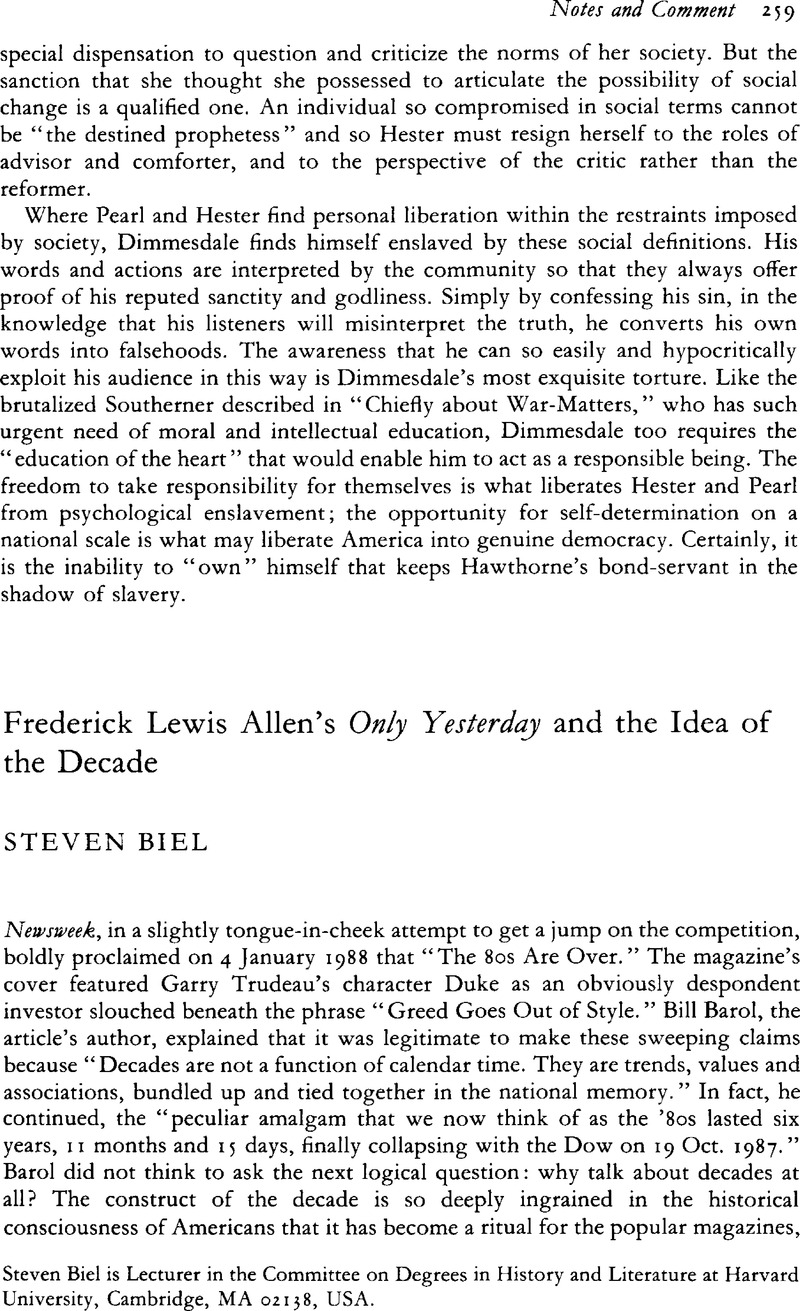Published online by Cambridge University Press: 16 January 2009

1 Barol, Bill, “The Eighties Are Over,” Newsweek, 4 01 1988, 40–48Google Scholar. Subsequent 1980s retrospectives included special issues of Life, People, and TV Guide in the fall and winter of 1989, and features in Esquire, Glamour, Essence, U.S. News and World Report, Christianity Today, Business Week, Discover, Seventeen, Ladies' Home journal, and Sport. Life's first decade-in-review issue appeared in 1940. A survey of the Readers' Guide to Periodical Literature suggests that the “1960s” produced the most retrospectives to date. It has become increasingly common in these journalistic histories to hint at problems in writing about decades and then to ignore such caveats completely.
2 “In Brief Review,” The Bookman, 10 1926, 236Google Scholar. Interestingly, the Reader's Guide did not list any articles about decades until 1940.
3 Kennedy, David M., “Revisiting Frederick Lewis Allen's Only Yesterday,” Reviews in American History, 14 (1986), 309.CrossRefGoogle Scholar
4 Life, for example, noted in 1940 that “More than a calendar decade, the 1930s were an era – with precise chronological limits. The era began on Oct. 29, 1929, with the stock-market crash and ended on Sept. 3, 1939, with Great Britain's declaration of war on Adolf Hitler.” The article then cited Allen's, sequel to Only Yesterday – Since Yesterday: The Nineteen-Thirties in America, September 3, 1929 – September 3, 1939Google Scholar – and noted its “even neater historical bracketing.” See “The Thirties: An Album,” Life, 26 02 1940, 67Google Scholar. Barol's use of the 1987 stock market crash to end the 1980s in the Newsweek retrospective suggests an attempt to tap into the popular conception of the 1920s.
5 Allen, Frederick Lewis, Only Yesterday: An Informal History of the Nineteen-Twenties (New York: Harper & Brothers, 1931), xiv.Google Scholar
6 Ibid., 25, 77, 238, 86.
7 Ibid, 10, 70, 91, 145, 168, 169.
8 Kennedy, , 314–16Google Scholar; Allen, , 112.Google Scholar
9 The application of labels for decades, regardless of the positive or negative connotations of these labels, enhances the sense of social cohesion: for example, the “Roaring Twenties,” the “Turbulent Sixties,” or the “Me Decade.” As the editors of Life wrote in 1969, “It is tempting for historians – and perhaps even more so for journalists – to paste a specific label on a decade. Life has labeled this special double issue on the 1960s ‘The Decade of Tumult and Change.’ It certainly was that.” See “A Divided Decade: The '60s,” Life, 26 12 1969, 8Google Scholar. Even this label of a “divided decade” implied shared experiences, common responses, and unified movement from “a brisk feeling of hope” to “a growing swell of demands for extreme and immediate change” or, more succinctly, “turbulence.”
10 Allen, , 186, 189Google Scholar; Kennedy, , 312. The emphasis is Allen's.Google Scholar
11 Allen, Frederick Lewis, transcript of radio broadcast, Armstrong Quakers' program, WJZ and NBC network, 8 12 1931Google Scholar, Frederick Lewis Allen Papers, Library of Congress; Allen, , Only Yesterday, 121.Google Scholar
12 Allen, , Only Yesterday, 356–57; Allen, WJZ radio broadcast, Allen Papers.Google Scholar
13 Marling, Karal Ann, Wall-to-Wall America: A Cultural History of Post Office Murals in the Great Depression (Minneapolis: University of Minnesota Press, 1982), 9Google Scholar; Allen, , Only Yesterday, 206Google Scholar; Kennedy, , 313Google Scholar See also Susman, Warren I., “Culture and Commitment” and “The Culture of the Thirties,” in Culture as History: The Transformation of American Society in the Twentieth Century (New York: Pantheon, 1984), 150–83, 184–210.Google Scholar
14 Book-of-the-Month Club News, 11 1931Google Scholar, Allen Papers. For a compelling interpretation of BOMC and its panel of judges, see Rubin, Joan Shelley, “Self, Culture, and Self-Culture in Modern America: The Early History of the Book-of-the-Month Club,” Journal of American History, 71 (1985), 782–806.CrossRefGoogle Scholar
15 Cardinal's Literature Committee, The Catholic Book Survey, 06 1932, 5, Allen Papers.Google Scholar
16 Life offered similar reassurances of progress in its '60s issue: “This issue contains its full share of turbulence and angry faces, but it would be the height of pessimism to read these as portents of disaster. In the record of history the times of greatest change and progress are never tranquil. The passage of America through the '60s seems in close retrospect too frantic and troubled, but out of such travail other times have yielded better worlds. That hope should sustain and guide us as we move forward into the '70s.” See “A Divided Decade,” 9. In 1940, Collier's reasoned that since the bright hopes for the 1930s had crumbled, the “glum” outlook for the 1940s might well prove mistaken: “[E]verything seemed to be jogging along pretty promisingly when 1930 came in, and practically everything went sour soon after the thirties got under way. Isn't it possible that the sour promises of 1940 may go sweet before too long?” See “Dangerous Decade,” Collier's, 6 01 1940, 50Google Scholar And Time combined the messages of optimism and social cohesion in its epitaph for the 1970s: “There is an impression now of national unity, a feeling that the U.S. is emerging from the privatism and divisions of the Me Decade.” See Morrow, Lance, “Epitaph for a Decade: A Lost War, A Discovery of Limits – and Good Cause for Optimism,” Time, 7 01 1980, 39.Google Scholar
17 Rubin, , 789–96Google Scholar See also Lears, T. J. Jackson, “From Salvation to Self-Realization: Advertising and the Therapeutic Roots of the Consumer Culture, 1880–1930,” in Fox, Richard Wightman and Lears, T. J. Jackson (eds.), The Culture of Consumption: Critical Essays in American History, 1880–1980 (New York: Pantheon, 1983), 1–38Google Scholar, and Marchand, Roland, Advertising the American Dream: Making Way for Modernity, 1920–1940 (Berkeley: University of California Press, 1985).Google Scholar
18 Allen, WJZ radio broadcast, Allen Papers.
19 Advertisements for “The Only Yesterday Game” and “Only Yesterday” the film; clipping from the New York Herald Tribune, 10 11 1933, Allen Papers. There is no evidence of Allen's reactions to the game or movie, except that he kept these advertisements and clippings among his personal papers.Google Scholar